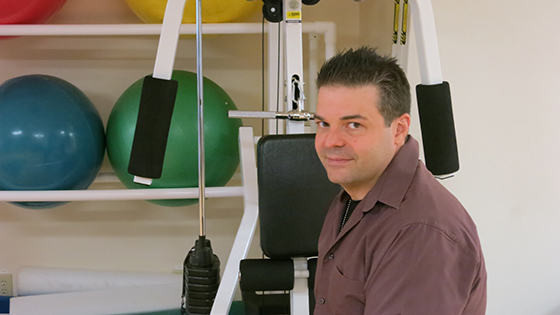
Greg Noack was attacked from behind on his way home from work in 1996. It left him in a coma for 15 days. (Photo: UHN)
Greg Noack was 24 when he moved from Ontario to Victoria, B.C. He had just graduated from college and was looking forward to a fresh start.
One early morning in 1996, as he was returning home from his graveyard shift at the hotel, Noack was attacked from behind by a group of men.
He doesn’t remember being struck on the head. He does remember waking from a 15-day coma to learn he had suffered a traumatic brain injury (TBI).
Noack, through the care of his health-care team, relearned how to walk, write, and feel particular emotions.
“I was enamoured by what my therapists were able to do for me,” said Noack. “I was lucky that I got back most of my function.”
Three years post-injury, Noack enrolled in Sault College’s Occupational Therapist Assistant/Physical Therapist Assistant Program and graduated with honours.
Shortly after, Noack was hired by the Toronto Rehab Acquired Brain Injury Rehab team as an occupational therapist assistant and later became a rehab therapist.
Most recently, he was seconded to Dr. Robin Green’s traumatic brain injury research team.
Dr. Green, Senior Scientist and Neuropsychologist, Toronto Rehab and Canada Research Chair in Traumatic Brain Injury, and her Toronto Rehab team have been studying impediments to brain injury recovery as well as treatments to offset the impediments.
Dr. Green’s work suggests that moderate-severe TBI may be a progressive neurological disorder –a whole new way of perceiving the condition.
“What may be occurring after a serious brain injury,” said Dr. Green, “is that damaged tissue is leaving healthy areas of the brain disconnected and under stimulated. Over time, healthy areas may deteriorate.”
Importantly, they discovered that in people with chronic moderate-severe TBI, environmental enrichment – increased physical, social and cognitive stimulation - can offset this deterioration.
Her research paper, entitled “Environmental enrichment may protect against hippocampal atrophy in the chronic stages of traumatic brain injury,” was published September 24 in Frontiers in Human Neuroscience.
In their study of 25 patients with moderate-severe TBI, her team found a positive reaction to environmental enrichment.
Those who reported greater amounts of environmental enrichment – for example, reading, problem solving exercises, puzzles, physical activity, socializing – at 5 months after their injury showed less shrinkage of the hippocampus (associated with memory functioning) from 5 to 28 months post-injury.
“People with moderate-severe TBI are commonly unable to return to the same level of engagement in their work, school or social lives as before the injury,” said Dr. Green. “However, those with greater environmental enrichment may be keeping vulnerable areas stimulated. Environmental enrichment is also known to increase production of neurons in the hippocampus and to promote their integration into existing brain networks.”
Based on the findings from their study, Green's team is now engaged in research designed to proactively offset deterioration, which includes the delivery of environmental enrichment to patients. Noack is instrumental in delivering enriched therapy for TBI patients who are enrolled in one of Dr. Green’s research studies.
“One thing I loved about this study is that it facilitated greater customization of a patient’s care,” said Noack. “I could see how my patients benefited from the increased amount of stimulation through extended therapy.”
“Although the brains of patients are showing negative changes, patients are still showing recovery of their functioning in spite of it,” said Dr. Green. “If we are able to offset the negative brain changes through the treatments we are developing, we may be able to very significantly improve patients’ recovery and the quality of their aging with a brain injury.”
